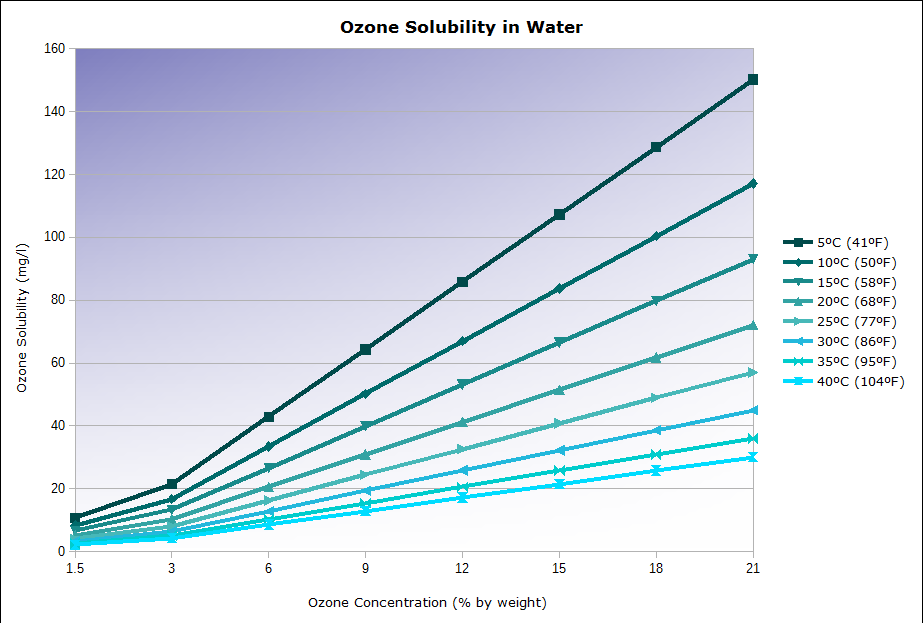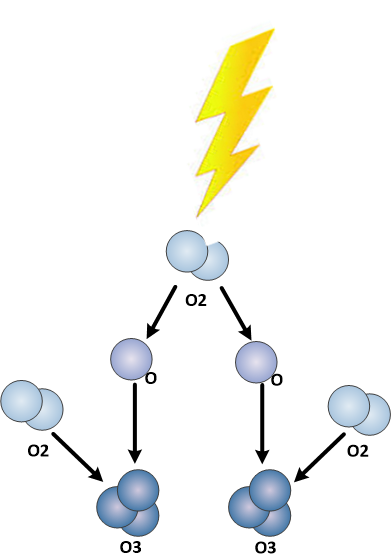Fundementals of Ozone Solubility
Ozone Solubility in Liquid can be expressed as the saturation point of ozone in water. Solubility of ozone will be the greatest limiting factor in getting ozone to dissolve into any liquid. As water is the most common liquid ozone is dissolved into, for the purpose of this article we will use only water as the liquid we are calculating ozone saturation.
Ozone Solubility is dependent upon the temperature of water, concentration of ozone gas, and pressure of water. This article will illustrate how these factors alter ozone solubility.
When ozone is dissolved in a liquid Henry's Law is obeyed closely. Therefore a saturation ratio must be determined (volume of gas dissolved / volume of liquid). Based on the saturation ratio of ozone the solubility of ozone can be expressed as the following:
CL = CG x S x P
where:
CL = dissolved concentration in liquid (mg/l)
CG = gas concentration (g/m3)
S = bunsen coefficient (solubility ratio), temperature dependent
P = gas pressure (in atmospheres)
Ozone Solubility Ratio:
The table below illustrates the solubility ratio of ozone, or S as shown in the calculation above.
The ozone solubility ratio is the ratio of ozone gas volume / liquid volume that can dissolve into water. These are derived from Henry's law constants based on water temperature. This ratio is used to determine the potential solubility of ozone gas into water using Henry's Law equation listed above. Below this calculation is used in a few examples for reference.
For an example of this calculation at work:
| CL | = | CG | * | S | * | P |
| 50 mg/l | = | 100 g/m3 | * | 0.5 | * | 1 |
| 33.4 mg/l | = | 85.8 g/m3 | * | 0.39 | * | 1 |
This calculates for ozone solubility in water at atmospheric pressure (1 atm= 14.7 psia). Actual solubility is a theoretical maximum based on saturation of ozone into water. Many other factors will play a role in actual dissolved ozone levels in water. Organic loading, PH, ozone half-life, etc will all lower actual dissolved ozone levels in water. These calculations are helpful in determining what is and is not possible with your current ozone equipment, along with understanding the factors that play a role on ozone dissolved into water.
Effect of Temperature and Ozone Concentration on Ozone Solubility:
The table below shows ozone solubility in water based on water temperature and ozone concentration (shown in % by weight). These are the values most commonly used in the industry and give an easy reference tool.
 % by weight assumes ozone from oxygen. 14.3 g/m3 = 1%.
% by weight assumes ozone from oxygen. 14.3 g/m3 = 1%.
This data is also illustrated in the chart below for easy visual reference.
This chart shows the dramatic difference temperature and ozone concentration plays on ozone solubility into water. This shows that a small change in water temperature may create a large difference in potential ozone dissolved into water. Also, changes in ozone concentration (dry air to oxygen) will change the ozone solubility dramatically.
While temperature is a variable we cannot control on many systems, ozone concentration is a variable we can control. Increasing the ozone concentration from 3 to 9% can overcome a dramatic temperature difference.
Effect of Pressure on Ozone Solubility:
Table below shows the difference pressure plays on Ozone Solubility. Ozone concentration of 6% by weight, and water temp of 15-deg C. Calculated for differences in ozone solubility based on water pressure.
Water pressure is entered into the solubility calculation as P. Water pressure is calculated as atmospheric pressure. 0 psig = 1 atmosphere = 14.7 psia. As pressure on the water increases the solubility of ozone increases. The table above, and chart below is an example of this calculation based on ozone concentration of 6% by weight (85.8 g/m3) and 15-deg C water temperature. These are very average values for many ozone applications.
The Chart below shows the table data above illustrated in a chart.
It is evident that pressure makes a dramatic difference on ozone solubility in water. Higher water pressure = higher ozone solubility = higher mass transfer of ozone into water. However, also be aware what differences water pressure may make on gas transfer for sheer effect, and more rapid decomposition of ozone gas.
Summary:
-Higher ozone concentrations = higher dissolved ozone levels in water
-Lower water temperatures = higher dissolved ozone levels in water
-Higher water pressure = higher dissolved ozone levels in water
Apply this information to your application:
Ozone is transferred into water in 2 main methods. Bubble diffusers and Venturi Injectors. Both method's goals are the same, dissolve ozone into water. With the information, we reviewed we can put it to use to achieve the best mass transfer of ozone into water as possible. We will discuss each along with ozone generator differences.
Ozone Generators:
At the heart of every ozone system is an ozone generator. It is evident from the information provided that ozone concentration plays a dramatic role in ozone solubility, and therefore, mass transfer of ozone into water. The type of ozone generator you choose will play a major role on mass transfer of ozone in water. Only corona discharge ozone generators will be discussed as UV ozone generators have no merit in dissolving ozone in water, and electrolytic ozone generators already did this job.
Ozone can be produced from dry air or oxygen. As air-fed ozone generators are using only the oxygen in the ambient air (~20%) the resulting ozone concentration is much lower. Therefore, an oxygen-fed ozone generator will ALWAYS have a better mass transfer of ozone into water than dry air. Most dry air ozone generators produce ozone at 1.5 - 3% by weight. While most oxygen-fed ozone generators produce ozone at 4.5 - 10% by weight.
Also, oxygen is more soluble into water than air. Therefore the carrier of ozone itself will also dissolve into water more efficiently.
Ozone Generators are air cooled or water cooled to remove the heat produced from ozone production. Water cooled ozone generators will typically cool the cell more efficiently and produce ozone at higher concentrations. Also, cooling water (or ambient air temp) will affect ozone concentrations. Cooler temperatures will create higher concentrations of ozone, and higher ozone solubility!
Ozone output (g/hr) is not the only number to base your ozone generator choice on. If your goal is to create 10 mg/l of ozone in water but your ozone generator only produces ozone at 1% by weight, it can produce as much ozone in g/hr as you desire, but it will never achieve your goal. Ozone concentration is just as important and in some applications, more important than overall ozone output in g/hr.
Water Temperature:
In most applications, we have no control over water temperature. This is simply a value we must be aware of, and plan accordingly. In higher temperatures, applications use ozone generators with the highest concentration of ozone available to overcome this issue. Be careful when increasing water pressure as increased pressures can also increase temperature.
In small applications, it may be acceptable to place laboratory glassware in ice, or a cooler environment. Whenever possible use the coldest water temperatures possible. In process applications when choosing where to dissolve ozone into water, look for the process step where water temperature is the coolest.
Water Pressure:
The data above shows that an increase in water pressure from 5 PSIG to 25 PSIG doubles ozone solubility. In some applications, a small increase in water pressure may make a dramatic difference in ozone mass transfer into water.
It is also important to remember that as water pressure decreases ozone solubility decreases. Therefore, when high levels of ozone are dissolved into water and that water is released to the atmosphere with a spray wand, or the end of a hose, ozone off-gassing may occur. This could be a safety concern that can be alleviated by adjusting other variables or eliminating a sharp decrease in water pressure.
Bubble Diffusers:
Ozone may be bubbled into water, or another liquid, in systems as small as a beaker in a lab, or as large as a municipal water plant contact basin. Bubble diffusers can, and do provide sufficient mass transfer of ozone into liquid if implemented properly.
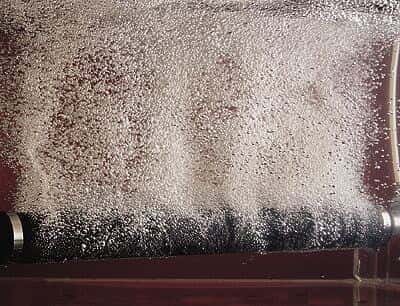
Smaller bubbles have greater surface area per volume and therefore increase mass transfer into water. Use the smallest pore diffuser available.
Vessel height will provide a 2 fold advantage. Taller vessels create a higher water pressure at the bottom of the vessel where the diffuser is normally placed. Higher water pressure equals higher ozone solubility. Also, taller vessels will increase the time the bubble is in the water and increase the time available for ozone to transfer into the water. With sufficient height and other necessary variables, bubble diffusers can achieve mass transfer of ozone into water that equals any other system.
Learn more about bubble diffusers HERE.
Venturi Injector:
When using venturi injectors a pressure differential across the venturi creates a vacuum that pulls ozone gas into water and mixes it with water efficiently. Venturi injectors can be used in pressurized pipelines and systems to also incorporate the benefit of pressure to increase ozone solubility.
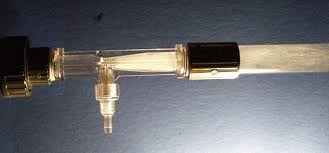
Venturi injectors allow for sealed contained systems to eliminate ozone off-gas from water during the mixing process.
Learn more about venturi injectors HERE.
Static Mixer:
Static Mixers can dissolve ozone gas into flowing, pressurized water directly in a pipeline. Ozone gas can be entered into the water with a simple TEE with a static mixer placed downstream to mix and dissolve these ozone gas bubbles into the water.
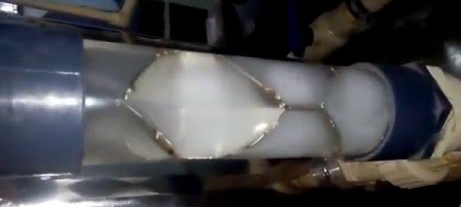
Water pressure on the pipeline increases ozone solubility allowing a static mixer, if incorporated properly to be very efficient at dissolving ozone into water.
Learn more about static mixers HERE.
Additional Information Links:
Ozone Dosage vs Dissolved Ozone
Dissolve Ozone into water with Bubble Diffuser
Dissolve Ozone into water with Venturi Injector
Dissolve ozone into water with Static Mixer
Compare Venturi Injector and Bubble Diffusers



